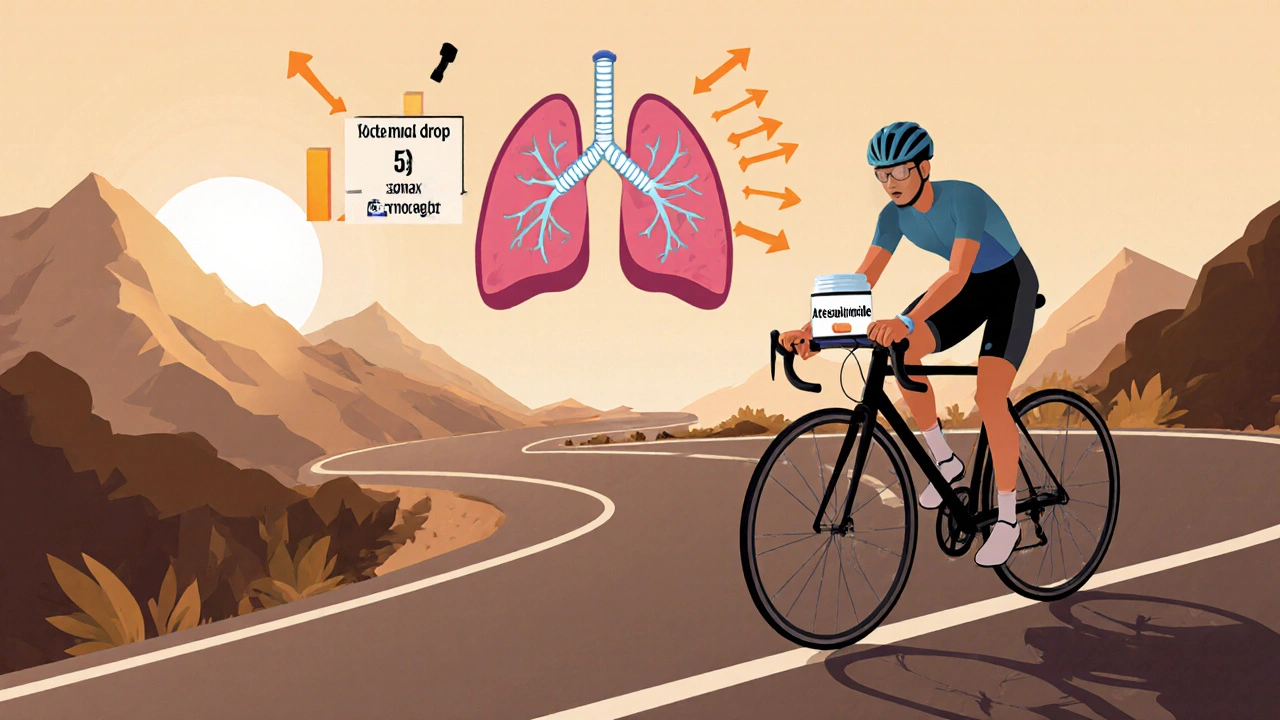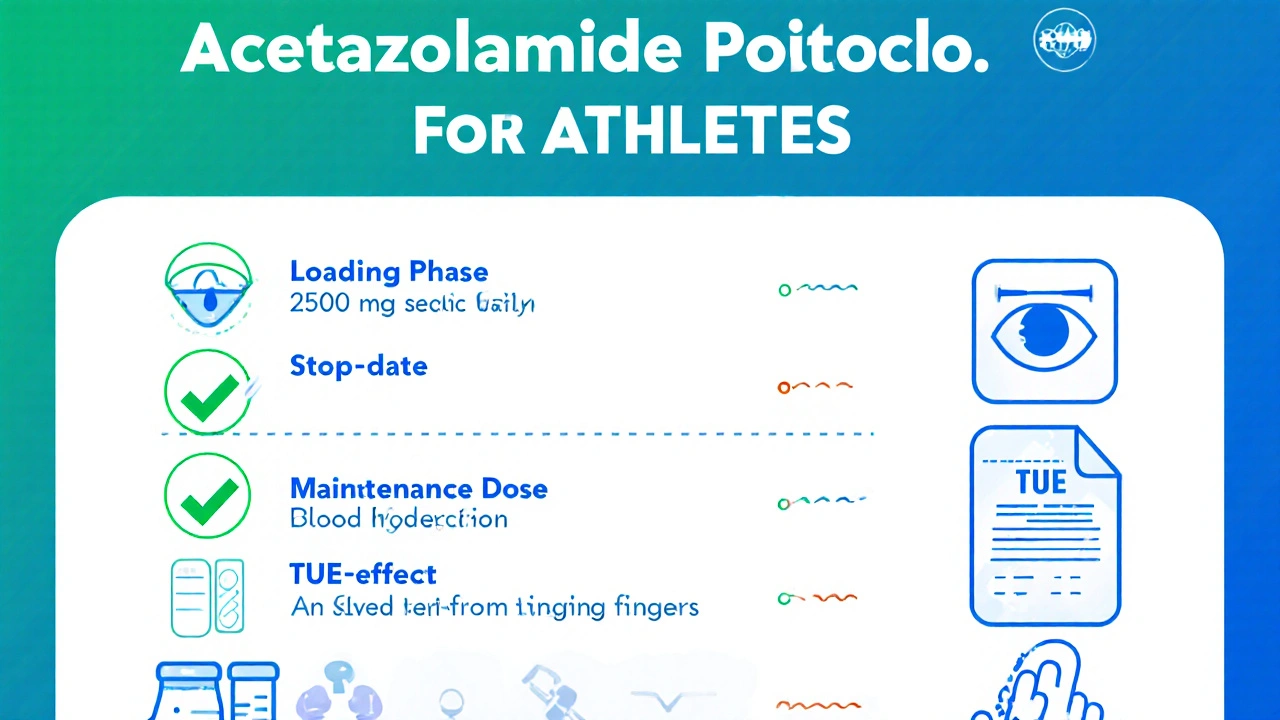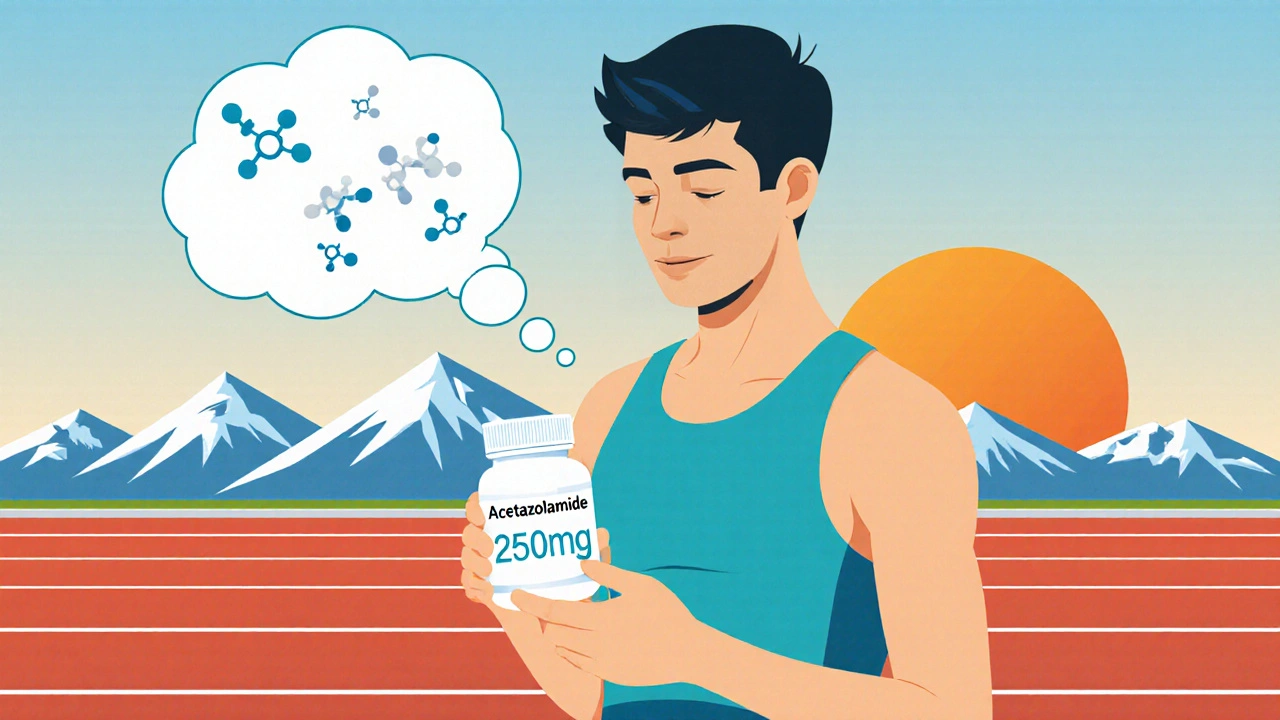Acetazolamide Dosing Calculator
Calculate Your Acetazolamide Dose
Recommended Dosing Schedule
Based on your inputs, here is the appropriate dosing schedule:
Important Considerations
Consult with a sports medicine physician before use. Monitor for side effects such as tingling in extremities or gastrointestinal discomfort. Acetazolamide is not a substitute for proper altitude acclimatization.
WADA compliance: Acetazolamide is monitored but not prohibited. File a TUE if competing in events with strict blood parameter limits.
When an athlete wonders whether a prescription drug could boost endurance, the first name that pops up is acetazolamide. It’s a carbonic anhydrase inhibitor most known for treating glaucoma and altitude sickness, but its impact on exercise physiology is a hot topic among coaches and sports physicians.
Acetazolamide is a synthetic sulfonamide that inhibits the enzyme carbonic anhydrase, leading to increased renal excretion of bicarbonate and a mild metabolic acidosis. The drug is typically prescribed at 250‑500 mg daily for altitude prophylaxis, but athletes sometimes experiment with lower doses to manipulate blood pH during training.
How Acetazolamide Works in the Body
Understanding the mechanism is key before you decide to add the pill to a training regimen. The enzyme Carbonic Anhydrase catalyzes the reversible conversion of carbon dioxide and water into carbonic acid, which quickly dissociates into bicarbonate and hydrogen ions. By blocking this enzyme, acetazolamide forces kidneys to dump bicarbonate, lowering plasma pH and creating a controlled metabolic acidosis.
This shift has two main effects for an exercising athlete:
- It stimulates ventilation - the body tries to expel excess CO₂, which can improve oxygen uptake during high‑altitude exposure.
- It enhances the Bohr effect - lower pH causes hemoglobin to release oxygen more readily to working muscles.
Both pathways sound promising for endurance, but the reality depends on dose, timing, and individual tolerance.
Acetazolamide and Altitude Training
Altitude training-living or training at elevations above 2,000 m-relies on hypoxia to trigger erythropoietin (EPO) production and boost red‑cell mass. The problem is that altitude also depresses VO₂ max, especially during the first few days. Athletes sometimes use acetazolamide to speed up acclimatization.
A 2023 field study of 24 elite cyclists showed that a 250 mg dose taken twice daily for 48 hours before ascent reduced the drop in VO₂ max from 12 % to 5 % compared with a placebo group. The same study noted a modest increase in ventilation rate (by 8‑10 %) and a quicker return to sea‑level performance after a 10‑day high‑altitude camp.
While these results are encouraging, they come with a caveat: the study participants were all medically screened and monitored for electrolyte balance. Unsupervised use can backfire.
Dosage Guidelines for Athletes
There is no one‑size‑fits‑all regimen, but most sports physicians recommend the following protocol for a short‑term altitude exposure:
- Loading phase: 250 mg orally every 12 hours for 2‑3 days prior to ascent.
- Maintenance phase: 125‑250 mg every 12 hours while at altitude.
- Stop‑date: Discontinue 24 hours before returning to sea level to allow plasma bicarbonate to normalize.
For sea‑level training, the dosing is usually lower (125 mg once daily) and only considered when an athlete is trying to induce a mild acidosis to stimulate buffering capacity. However, this off‑label use is rarely endorsed without a medical prescription.

Potential Side Effects and Health Risks
Because acetazolamide forces the kidneys to lose bicarbonate, it can lead to:
- Electrolyte disturbances - especially low potassium and sodium.
- Kidney stone formation - due to increased urinary calcium.
- Gastrointestinal upset - nausea, metallic taste, and occasional vomiting.
- Neurological symptoms - tingling in the fingers and toes (paresthesia) or mild headache.
Most athletes who stick to the recommended dose report only mild tingling that resolves when the drug is stopped. The bigger danger lies in combining acetazolamide with other diuretics or high‑dose NSAIDs, which can precipitate severe dehydration and renal injury.
WADA, Doping Regulations, and Ethical Considerations
The World Anti‑Doping Agency (WADA) does not list acetazolamide as a prohibited substance, but it appears on the Doping Regulations monitoring list. This means athletes must disclose therapeutic use through a TUE (Therapeutic Use Exemption) if the drug is taken in a sport that has strict blood‑parameter limits.
Key points for compliance:
- Obtain a written prescription from a qualified physician.
- File a TUE with the relevant national anti‑doping organization before competition.
- Maintain a log of dosage, timing, and any side effects for audit purposes.
Failure to disclose can result in a violation, even though the compound itself is not banned.

Practical Checklist for Athletes Considering Acetazolamide
- Consult a sports medicine doctor and discuss altitude goals.
- Get baseline blood chemistry - focus on bicarbonate, potassium, and creatinine.
- Plan dosing schedule at least 48 hours before ascent.
- Hydrate well; aim for at least 2‑3 L of fluid per day.
- Monitor for tingling, nausea, or excessive fatigue; stop the drug if symptoms worsen.
- Document everything for a potential TUE submission.
Comparison Table: Acetazolamide vs Placebo in Altitude Training
| Metric | Acetazolamide (250 mg BID) | Placebo |
|---|---|---|
| Drop in VO₂ max | 5 % vs sea‑level baseline | 12 % vs sea‑level baseline |
| Ventilation increase | +9 % | +3 % |
| Time‑to‑exhaustion (km cycling) | +7 % | ±0 % |
| Reported side effects | Tingling (30 %), mild nausea (10 %) | None |
| WADA status | Monitored - requires TUE if used competitively | Not applicable |
Frequently Asked Questions
Can acetazolamide replace altitude training?
No. The drug can speed up acclimatization and soften the initial drop in VO₂ max, but it does not stimulate erythropoiesis like genuine hypoxic exposure.
Is the mild metabolic acidosis dangerous?
For healthy adults on short‑term, low‑dose regimens, the acidosis is usually well‑tolerated. Problems arise if the athlete is dehydrated, has renal impairment, or combines it with other acid‑producing drugs.
Do I need a prescription to use it for performance?
Yes. In most countries acetazolamide is prescription‑only. Using it without medical oversight can lead to legal issues and health risks.
How long should I stay off the drug before a race?
Most experts advise discontinuation at least 24 hours before competition to let bicarbonate levels normalize and avoid unexpected side effects.
Is acetazolamide allowed under WADA rules?
It is not banned, but it is on the monitoring list. Athletes competing in events with strict blood‑parameter limits should file a TUE.



 Medications
Medications





kenny lastimosa
October 23, 2025 AT 16:16When you look past the hype you see a simple acid‑base shift that nudges the body’s breathing drive, a subtle lever that athletes can pull without breaking the bank. The drug’s carbonic anhydrase blockade creates a controlled metabolic acidosis, prompting the lungs to breathe more deeply. In quiet reflection this means you might shave a few seconds off a climb without courting danger.
Kajal Gupta
November 1, 2025 AT 17:56Wow, that rundown really paints the picture in bright strokes – imagine your blood as a musical instrument, and acetazolamide as the subtle tuner that sharpens the notes of oxygen delivery. It’s like sprucing up a vintage bike with a sleek new chain; the ride feels smoother, the cadence steadier. For anyone juggling altitude dreams and marathon miles, this guide drops a handful of practical pearls that sparkle without overwhelming the reader.
Zachary Blackwell
November 10, 2025 AT 20:36What most folks don’t see is how the pharma giants quietly bundle this “benign” pill with a cascade of hidden clauses that steer athletes toward a dependence loop, all while wearing the friendly smile of a supportive trainer. The monitoring list on the WADA roster isn’t just bureaucratic red tape; it’s a subtle beacon for the industry to keep an eye on usage patterns and feed data back to research labs. In the shadows of altitude camps, the whisper of a “performance edge” becomes a loud echo of corporate reach, nudging competitors to accept a prescription that feels almost mandatory.
prithi mallick
November 19, 2025 AT 23:16Honestly i think the best way to try this is with a coach who watches your electrolytes like a hawk and reminds you to drink plenty water, the tingling is usually harmless and goes away when u stop taking it. just make sure you get a baseline blood test so you know where you stand before you start the protocol. if you feel any weirdness, especially knee or stomach pain, pause the med and re‑evaluate.
Michaela Dixon
November 29, 2025 AT 01:56Acetazolamide sits at a crossroads of chemistry and performance, acting as a carbonic anhydrase inhibitor that reshapes the body's acid‑base balance. By forcing the kidneys to dump bicarbonate the bloodstream becomes slightly more acidic and the respiratory center ramps up ventilation. This increased breathing pulls more oxygen into the alveoli which can be a boon when the air is thin. The Bohr effect also shifts, allowing hemoglobin to release oxygen more readily to the muscles that are working hard. For an athlete chasing marginal gains this chain of events feels like unlocking a hidden gear in a well‑tuned machine. The data from the 2023 cyclist study shows a reduction in VO₂ max loss from twelve percent to five percent when a loading dose is used. That is a measurable advantage that can translate to a few extra minutes on a long climb. The same study noted an eight to ten percent rise in ventilation rate which suggests the body is compensating for the induced acidosis. However the protocol is not without caveats the side effect profile includes tingling in the extremities and occasional nausea. Electrolyte disturbances especially low potassium can creep in if hydration is not maintained. Kidney stone risk rises modestly due to increased urinary calcium, a factor that should not be ignored in high‑intensity training cycles. Athletes who combine acetazolamide with diuretics or high doses of NSAIDs amplify the dehydration risk dramatically. The World Anti‑Doping Agency places the drug on a monitoring list, meaning that while it is not banned it still draws scrutiny from anti‑doping officials. A Therapeutic Use Exemption becomes necessary if competition blood parameters are tightly regulated. In practice the drug works best for short‑term altitude exposure rather than as a daily performance enhancer. Ultimately the decision to use it should rest on a thorough medical evaluation, careful dosing, and a clear understanding of the physiological trade‑offs involved.
Scott Ring
December 8, 2025 AT 04:36From a cultural standpoint it’s fascinating how a medication originally meant for eye pressure finds a second life on the high‑altitude trails of the Himalayas and the Rockies, bridging medical tradition with modern sport. The casual chat over a post‑workout coffee often turns into a story about how local sherpas used similar tricks centuries ago, showing that we’re just repackaging ancient wisdom for today’s athletes.
Shubhi Sahni
December 17, 2025 AT 07:16Indeed, the integration of acetazolamide into training regimens, when done responsibly, offers a spectrum of physiological benefits, such as enhanced ventilation, improved oxygen off‑loading, and a smoother acclimatization curve, all of which can be pivotal for elite competitors; however, the potential drawbacks-including electrolyte imbalances, renal stress, and the need for thorough medical supervision-must be weighed carefully, especially when athletes are already navigating complex nutritional plans and rigorous schedules.